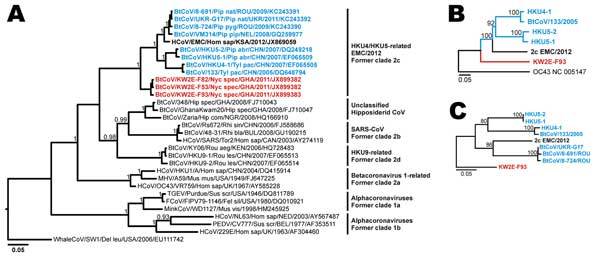Volume 19, Number 3—March 2013
Dispatch
Human Betacoronavirus 2c EMC/2012–related Viruses in Bats, Ghana and Europe
Figure 2

Figure 2. . . RNA-dependent RNA polymerase (RdRp) gene and Spike genephylogenies including the novel betacoronaviruses from bats in Ghana and Europe. A) Bayesian phylogeny of an 816-nt RdRp gene sequence fragment corresponding to positions 14781–15596 in severe acute respiratory syndrome coronavirus (SARS-CoV) strain Frankfurt 1 (GenBank accession no. AY291315). Data were analyzed with MrBayes version 3.1 (http://mrbayes.sourceforge.net/) by using a WAG amino acid substitution model and 4 million generations sampled every 100 steps. Trees were annotated by using a burn-in of 10,000 and visualized with FigTree version 1.6.1 from the BEAST package (www.beast.bio.ed.ac.uk). A whale gammacoronavirus was used as an outgroup. The novel Nycteris bat viruses are shown in boldface and red, the novel Pipistrellus bat viruses and other bat CoVs in the 2c clade are shown in boldface and cyan, and the novel human betacoronavirus EMC/2012 is shown in boldface. Values at deep nodes represent statistical support of grouping by posterior probabilities. CoV clades are depicted to the right of taxa. B) Phylogeny of the complete Spike gene of clade 2c CoVs determined by using the neighbor-joining method with an amino acid percentage distance substitution model and the complete deletion option in MEGA5 (www.megasoftware.net). The Nycteris CoV Spike gene was equidistant from other 2c-CoV Spike genes with 45.6%–46.8% aa divergence. Human coronavirus (hCoV)–OC43 was used as an outgroup. No complete Spike gene sequence was available for VM314 or the novel Pipistrellus bat CoVs. Scale bar represents percentage amino acid distance. The analysis comprised 1,731 aa residues. C) Phylogeny of the partial Spike gene of clade 2c CoVs, including the novel CoVs of Pipistrellus bats from Europe, determined by using a nucleotide distance substitution model and the complete deletion option in MEGA5. Scale bar represents percentage nucleotide distance. The analysis comprised 131 nt corresponding to positions 25378–25517 in hCoV-EMC/2012. Oligonucleotide sequences of primers used to amplify full and partial Spike gene sequences are available on request from the authors. Values at deep nodes in B and C represent statistical support of grouping by percentage of 1,000 bootstrap replicates. GenBank accession numbers for the complete and partial Spike genes correspond to those given in panel A for the RdRp gene.
1These authors contributed equally to this article.
2Deceased.